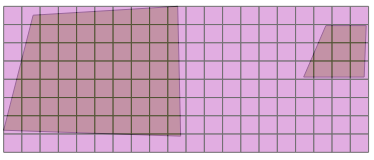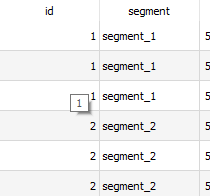I am trying to split polygons into equally sized pieces using a grid. The polygons are all image segments derived from 2.4 meter satellite imagery. So each polygon is a grouping of 2.4m x 2.4m squares. I want to produce a QGIS processing tool to simplify my current workflow of individually running the "Create Grid" and "Split with Lines" QGIS processing tools. The workflow should also edit the selected polygon in the existing layer, not create a new layer.
Example input polygon (with the polygon to be split selected):
Expected output from processing tool:

from qgis.core import *
from qgis.gui import *
import qgis.utils
import processing
import re
from PyQt5.QtCore import *
#the spacing of the cut grid
cell_size = 2.4
#get current layer, selection, CRS from QGIS map canvas
layer = qgis.utils.iface.activeLayer()
selected = layer.selectedFeatures()
crs = qgis.utils.iface.activeLayer().crs().authid()
for lay in selected:
#get the ID of the feature we've selected in QGIS map canvas
id = lay.id
print("working on: " + str(id))
#get the extent of the selected feature
x_max, y_max, x_min, y_min = re.split(":|,", lay.geometry().boundingBox().toString().replace(" ", ""))
extent = x_min + "," + x_max + "," + y_min + "," + y_max
print(extent)
#create our grid in memory
grid_parameters = {"TYPE": 1,
"EXTENT": extent,
"HSPACING": cell_size,
"VSPACING":cell_size,
"HOVERLAY": 0,
"VOVERLAY": 0,
"CRS": crs,
"OUTPUT": "memory_grid"}
grid = processing.run("qgis:creategrid", grid_parameters)
#split the selected feature, store the results in memory
split_parameters = {"INPUT": layer.getFeature(id),
"LINES": grid["OUTPUT"],
"OUTPUT": "memory_split"}
split = processing.run("qgis:splitwithlines", split_parameters)
#delete the original feature, add the split results to the original layer
with edit(layer):
layer.deleteFeature(id)
layer.addFeatures(split["OUTPUT"])
When I run this code I get an error on line 39 (split parameters dictionary) that reads: "TypeError: QgsVectorLayer.getFeature: argument 1 has unexpected type 'builtin_function_or_method"
I have tried several different approaches, including directly feeding my selection, the entire layer, layer.getFeatures(), etc. but nothing has been an acceptable input for the Split with Lines tool.






id = lay.idwithid = lay.id()